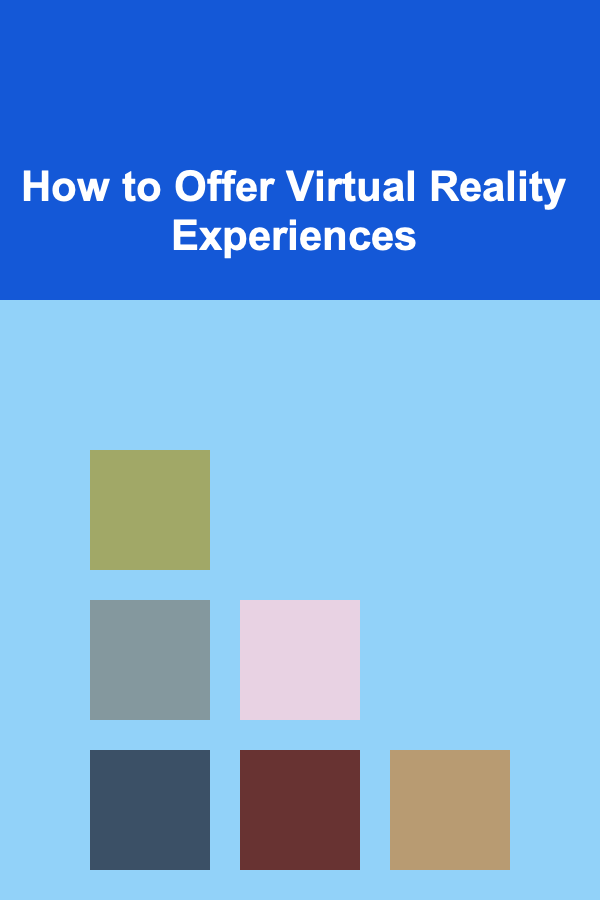
How to Offer Virtual Reality Experiences
ebook include PDF & Audio bundle (Micro Guide)
$12.99$9.99
Limited Time Offer! Order within the next:

Virtual reality (VR) has transitioned from a niche technology to an integral part of entertainment, education, healthcare, business, and beyond. Offering immersive virtual reality experiences has become a competitive edge for many industries. Whether you are a business owner, educator, healthcare provider, or content creator, understanding how to effectively offer VR experiences is essential. This article will explore in-depth how to offer compelling virtual reality experiences, discussing the technology involved, design principles, and strategies to maximize impact and engagement.
Understanding Virtual Reality
Before diving into offering VR experiences, it's crucial to understand what virtual reality is and how it works. At its core, VR is a computer-generated simulation of an environment that users can interact with in a seemingly real way. It provides an immersive experience by substituting the user's real-world environment with a simulated one.
1.1. Components of a Virtual Reality System
A typical VR system includes:
- Headset: The central device that houses the display and sensors. Popular models include Oculus Rift, HTC Vive, and PlayStation VR.
- Sensors and Controllers: These detect the user's movements and enable interaction with the virtual environment. Controllers or gloves can allow users to manipulate objects within the VR world.
- Software: This includes the virtual environment or experience itself, developed using tools like Unity, Unreal Engine, or custom VR software.
- Tracking Technology: Sensors placed on the headset or controllers track the position and orientation of the user's head and hands, creating a responsive and dynamic experience.
- Computing Hardware: Powerful computers or gaming consoles are often required to run VR software at high frame rates for smooth performance and realism.
Key Steps to Offering Virtual Reality Experiences
2.1. Defining the Purpose and Goals of the VR Experience
The first step in offering a VR experience is defining its purpose. What do you want your users to experience? VR experiences can vary greatly, from gaming to education to therapy. Understanding the goals of the experience will guide the design and development process.
2.1.1. Entertainment
If the VR experience is meant for entertainment, such as gaming or cinematic experiences, the focus will be on creating a thrilling and immersive environment. For example, VR can be used in interactive storytelling, where users are part of the narrative and make decisions that affect the outcome.
2.1.2. Education and Training
VR is a powerful tool for educational and training purposes, offering environments where users can engage with simulations that would be too risky, costly, or impractical in real life. VR is commonly used for medical training, flight simulations, and even history lessons that transport students to historical events.
2.1.3. Virtual Tourism
Virtual tourism allows users to visit remote or historically significant locations without leaving their home. These experiences often replicate iconic landmarks, cities, and even natural wonders, providing users with an educational and entertaining experience.
2.1.4. Healthcare and Therapy
VR has found applications in medical treatments, such as pain management, physical therapy, and psychological therapy. Virtual environments can be used to distract patients from pain or to create controlled environments for exposure therapy.
2.2. Selecting the Right VR Hardware
Once the purpose and goals of the VR experience have been defined, the next step is choosing the right hardware. There are various VR headsets available, each with different capabilities and features. Some considerations for hardware selection include:
- Platform Compatibility: VR headsets such as Oculus Quest 2 are standalone devices, while others like HTC Vive and Oculus Rift require a PC or console to operate.
- Resolution and Visual Quality: The visual quality is critical in creating an immersive experience. Look for headsets that offer high resolution (at least 1080p per eye) and wide field of view for a more realistic environment.
- Comfort and Ergonomics: VR headsets can be worn for extended periods, so ensuring that the device is comfortable is important. Adjustable straps, lightweight designs, and comfortable padding make for a better user experience.
- Controller and Input Methods: Depending on the nature of the VR experience, you may need motion controllers, haptic feedback devices, or even full-body tracking systems.
2.3. Developing or Acquiring VR Content
The next step in offering VR experiences is creating or acquiring content. This can be one of the most time-consuming and costly aspects of offering VR, depending on the type of experience you want to provide.
2.3.1. In-House Development
For businesses or educators with specific needs, developing custom VR content in-house may be necessary. This could involve:
- Game Development: Using engines like Unity or Unreal Engine to develop interactive experiences.
- 3D Modeling: Creating realistic models for environments, characters, or objects in the virtual world.
- Audio and Visual Design: Adding immersive soundscapes and high-quality visuals to enhance the realism and immersion of the VR experience.
- User Interaction Design: Ensuring that users can intuitively interact with the virtual environment through controllers, gestures, or even voice commands.
2.3.2. Acquiring Third-Party Content
For many businesses, creating custom VR content may not be feasible due to resource constraints. In these cases, purchasing or licensing third-party VR content might be the best option. VR content is available in a wide range of formats, from educational simulations to full-length cinematic VR films. Platforms like Steam, Oculus Store, and HTC Viveport offer VR content that can be purchased or licensed for public use.
2.4. User Experience and Interface Design
User experience (UX) design plays a vital role in VR. Unlike traditional media, VR immerses the user in a fully interactive environment, so UX must be carefully considered to ensure ease of use, engagement, and comfort.
2.4.1. Comfort and Motion Sickness
VR experiences should be designed to avoid discomfort, such as motion sickness. Motion sickness can occur when there is a disconnect between what the user sees and what their body feels. To prevent this, developers should:
- Maintain High Frame Rates: Lower frame rates can cause choppy movements, leading to nausea and discomfort. Aim for a consistent frame rate of at least 90Hz.
- Limit Rapid Movement: Fast, jerky movements should be avoided to prevent disorientation. If rapid movement is necessary, use features like teleportation or gradual transitions.
- Provide Comfort Options: Offering users adjustable settings for field-of-view and sensitivity can help mitigate discomfort.
2.4.2. Intuitive Interaction
Interactivity is at the heart of VR. Ensure that users can easily interact with objects, environments, and other users (in multiplayer experiences). This can be achieved through:
- Natural Hand Movements: Motion controllers should be responsive to the user's hand gestures and movements. Intuitive actions like grabbing, pointing, and pulling are essential for immersion.
- Clear Visual Cues: Provide users with visual cues such as highlighting interactive objects or showing them how to perform actions within the virtual environment.
- Feedback Mechanisms: Haptic feedback through controllers or tactile gloves can simulate physical sensations, adding a layer of immersion.
2.5. Testing and Iterating the VR Experience
Once the VR experience has been developed or curated, testing is essential. Conduct thorough testing to ensure that the experience runs smoothly on the chosen hardware and that users can navigate the environment comfortably. Key areas to focus on during testing include:
- Performance Testing: Ensure that the experience runs without lag or frame drops, as these can disrupt immersion and cause discomfort.
- User Testing: Gather feedback from users about their experience, focusing on aspects like ease of use, comfort, and engagement.
- Bug Testing: Identify and fix any bugs or glitches that could interrupt the experience, such as objects not responding to interactions or visual inconsistencies.
2.6. Offering VR Experiences to Users
With everything in place, it's time to offer the VR experience to users. The delivery method will depend on your audience and the nature of the VR experience.
2.6.1. Virtual Reality Arcades
If you run a VR arcade or entertainment center, you'll want to ensure your space is properly equipped. This includes having sufficient space for movement, comfortable headsets, and controllers, and a variety of experiences for users to choose from. Additionally, you may want to offer multiplayer VR games or experiences to enhance social engagement.
2.6.2. Online Distribution
For businesses offering VR experiences remotely, online distribution through platforms like Steam, Oculus, or HTC Viveport is essential. Distribute content through these platforms, ensuring that your experience is optimized for various hardware.
2.6.3. Education and Corporate Training
If you're offering VR for educational purposes or corporate training, consider providing a detailed guide or tutorial on how to use the system. Also, consider offering access to VR simulations for remote learning or virtual classrooms.
2.7. Enhancing Engagement with Multi-Sensory Integration
To further enhance the immersion of your VR experience, consider integrating additional sensory inputs like haptic feedback, motion tracking, and even scent or temperature simulations. Multi-sensory integration can make virtual experiences feel more lifelike and engaging, adding an extra layer of realism.
Marketing and Promoting Your VR Experience
Once you've developed and tested your VR experience, promoting it to your target audience is essential. Create marketing campaigns that highlight the unique aspects of the experience, whether it's the immersive environment, educational benefits, or innovative features. Consider offering free trials, discounted access, or demonstrations to entice potential users.
In conclusion, offering a successful virtual reality experience requires a combination of thoughtful planning, careful selection of hardware and content, and a user-centered approach to design. With the right tools, creativity, and testing, you can create an engaging, immersive, and memorable VR experience that will stand out in a competitive market. Whether for entertainment, education, or business applications, the future of VR holds exciting opportunities for those ready to embrace this transformative technology.

How to Build a Profitable Membership Site
Read More
How to Maintain Your Home's Hot Tub for Long-Term Enjoyment
Read More
How to Make Money Online as an NFT Collector/Curator: 10 Actionable Ideas
Read More
How to Make Your Home Safe for Pet Birds
Read More
How to Use Lighting to Create an Inviting Entryway
Read More
How To Master Coffee Grading and Quality Control
Read MoreOther Products

How to Build a Profitable Membership Site
Read More
How to Maintain Your Home's Hot Tub for Long-Term Enjoyment
Read More
How to Make Money Online as an NFT Collector/Curator: 10 Actionable Ideas
Read More
How to Make Your Home Safe for Pet Birds
Read More
How to Use Lighting to Create an Inviting Entryway
Read More